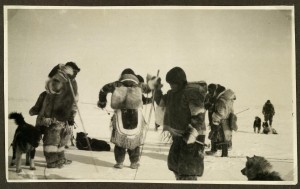Climate change adaptation: a call for a holistic and interdisciplinary approach

In my previous article on Arctic sovereignty I already touched upon the Inuit in the Arctic, the fact that they have territorial rights and that they are in an environmentally unjust situation. Today I will add something to the stack: the Inuit are very vulnerable to climate change and lack adaptive capacity due to a number of recent lifestyle changes.
Vulnerability, as this case will show, is not simply about structural environmental risks people have to deal with, such as the melting of sea ice and the thaw of permafrost. It is also in part formed by social, cultural, political and economic factors.

For a long time the Inuit relied on hunting, harvesting and sharing food among each other in order to secure their food supply. They did so through the knowledge they had gathered by passing it on from generation to generation. At the same time, this knowledge continuously changed according to new circumstances and practices. These two things ensured their adaptive capacity to environmental changes: they would have other people to fall back on when food became scarcer, and they learned to adapt their hunting and harvesting methods to these changes. This way they made sure the new generation knew what to do under these new circumstances.
But the Inuit lifestyle is changing. Due to more schooling and development in the north of Canada, Inuit society has started to shift towards a wage economy, wherein money has become the most important asset. This means that mostly the younger generation increasingly buys (innutritious) food in stores. The dependence on money makes them vulnerable to external market volatility. Aren’t we all, you might think? Well, yes, but the costs of living in the north are twice as high compared to the south of the country [1], while the average income of aboriginal people in the north lies far below the non-aboriginal average. The result is that a very high percentage of the population is prone to food insecurity if the market becomes unstable and food prices increase.
There is another consequence to the growing importance of money: it causes societal gaps. It is mostly the elder generation that relies completely on subsistence economy, where they provide for themselves through hunting and gathering, whereas many younger Inuit rely only partially on their environment for subsistence due to their jobs. The latter are also the ones that are able to buy new technology to boost their subsistence gains. However, the sharing of equipment and food is done less regularly than before or may involve monetary exchange now [2]. This makes the elderly especially vulnerable to climate change and market volatility because, in the light of declining food sharing networks, those excluded from the wage economy have less to fall back onto when food sources become scarce.
 The adoption of technologies furthermore reduces the necessity for land based skills and indigenous knowledge. A lack of knowledge means technological advanced equipment is needed. Younger Inuit also have less time for or less interest in indigenous knowledge because they have to go to school, work or play videogames [3]. No more time to learn about hunting skills and weather conditions, then, results therefore in less capacity to deal with the changing environmental conditions. Because indigenous knowledge is a practice of continuous adaptation, the existence of apt knowledge is threatened.
The adoption of technologies furthermore reduces the necessity for land based skills and indigenous knowledge. A lack of knowledge means technological advanced equipment is needed. Younger Inuit also have less time for or less interest in indigenous knowledge because they have to go to school, work or play videogames [3]. No more time to learn about hunting skills and weather conditions, then, results therefore in less capacity to deal with the changing environmental conditions. Because indigenous knowledge is a practice of continuous adaptation, the existence of apt knowledge is threatened.
There is a need to make sure that the Inuit in the north stop suffering from their economic inequality compared to the south, yet also to address the need for adaptive measures such as the revival of indigenous knowledge. The exploitation of the Arctic might mean more job openings for Inuit, but as we have seen this can also lead to a decrease in communal cohesion upon which the adaptive capacity is based. The real challenge then is to develop the living conditions of Inuit in a way that is congruent with Inuit culture and helps them be more resilient to climate change. An example of such a solution through which the economy is currently boosted, is by the government funding Inuit art. The educational programs should also include more indigenous knowledge. Land Camps have already been set up to teach young Inuit land-based skills.[4]
On a more general endnote, this case endorses the need for future research to address climate change not just on an environmental or socio-cultural level: there is a need for an interdisciplinary, holistic view.
[1] Gionet, L. (2009) Inuit in Canada: Selected findings of the 2006 census. Canadian Social Trends. Statistics Canada — Catalogue no. 1 1-008
[2] Ford, J. D., Pearce, T., Smit, B., Wandel, J., Allurut, M., Shappa, K., Ittusujurat, H. and Qrunnut, K. (2007) Reducing Vulnerability to Climate Change in the Arctic: The Case of Nunavut, Canada. Arctic, 60(2): 150-166
[3] Ford, J. D., Smit, B., Wandel, J. and MacDonald, J. (2006) Vul16nerability to climate change in Igloolik, Nunavut: what we can learn from the past and present. Polar Record, 42: 127-138
[4] Ford, J. D., Smit, B., Wandel, J. and MacDonald, J. (2006) Vul16nerability to climate change in Igloolik, Nunavut: what we can learn from the past and present. Polar Record, 42: 127-138
